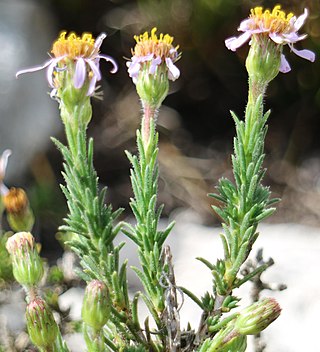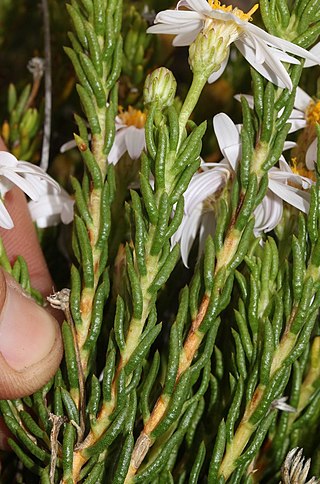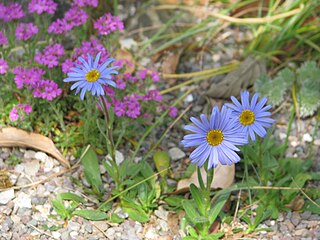
Felicia aethiopica is a low shrublet of up to about 50 cm high that is assigned to the family Asteraceae. It has rigid, leathery, inverted egg-shaped leaves, with only the lowest pair set oppositely. It has flower heads with an involucre of about 8 mm in diameter with bracts that each contain three resin ducts, and have one whorl of twelve to fourteen ray florets with about 11 mm long and 1½ mm wide blue straps surrounding many yellow disc florets. The plant is called wild aster or dwarf Felicia in English, and wilde-aster or bloublombossie in Afrikaans. Flowering occurs year-round. Wild aster can be found in the Western and Eastern Cape provinces of South Africa.

Felicia echinata, commonly known as the dune daisy or prickly felicia, is a species of shrub native to South Africa belonging to the daisy family. It grows to 1 m (3.3 ft) high and bears blue-purple flower heads with yellow central discs. In the wild, it flowers April to October.

Felicia canaliculata is a grayish green shrublet in the family Asteraceae that grows up to 40 cm (16 in) in height. It has narrow, awl-shaped leaves, relatively large flower heads with approximately a dozen light purple to white ray florets encircling many yellow disc florets. It can only be found in the Western Cape province of South Africa.

Felicia macrorrhiza is a small, evergreen shrub in the family Asteraceae. This species grows in the Karoo region of South Africa. It is called Aspoestertjie in Afrikaans.

Felicia oleosa is an evergreen, richly branched dwarf shrub of up to 30 cm (12 in) high, that is assigned to the family Asteraceae. It has narrow, awl-shaped leaves, with translucent oil or resin dots, pointing upwards, crowded on the younger stems. The flower heads have about thirteen bright blue ray florets, encircling many yellow disc florets. This species grows in the mountains dividing the Karoo region of South Africa. It is sometimes called oily blue daisy in English.

Felicia dregei is an evergreen, glandular shrub of up to 11⁄2 m (5 ft) high, that is assigned to the family Asteraceae. It has flat, finely felty, grayish green, narrowly elliptic to lance-shaped leaves of up to 4 cm long and 8 mm wide, with an entire margin or here and there with up to ten teeth. The flower heads have about ten violet ray florets, encircling many yellow disc florets. This species grows in the Northern Cape and Western Cape provinces of South Africa.

Felicia brevifolia is an evergreen, richly branched shrub of up to 11⁄2 m (5 ft) high, that is assigned to the family Asteraceae. It has elliptic to wedge-shaped leaves, of between 1⁄2 and 11⁄2 cm long, green to gray-green, many with several teeth. The flower heads have about fifteen blue-violet ray florets, encircling many yellow disc florets. This species grows in southern Namibia and the west of South Africa.

Felicia namaquana is a glandular-hairy, branching annual plant of up to 25 cm (10 in) high that is assigned to the family Asteraceae. It is sometimes called Bloublommetjie or pers poublom in Afrikaans. Flowering occurs between May and October. It grows in Namibia and South Africa.

Felicia rosulata is a hairy, perennial, herbaceous plant of up to 30 cm (1 ft) high, that is assigned to the family Asteraceae. It has a rosette of elliptic 8 cm × 2 cm leaves with 3–5 veins, and long, hairy stalks, each topped with one floral head consisting of about thirty middle blue ray florets encircling many yellow disc florets. It can be found in the mountains of Lesotho, eastern South Africa and Eswatini.

Felicia amoena is a variably hairy, sometimes glandular, biennial or perennial plant, of about 25 cm (10 in) high, that is assigned to the family Asteraceae. It is somewhat woody at its base, roots at the nodes if these contact the soil, and has ascending branches. The leaves are oppositely arranged along the stems at and just above a branching fork, further up the leaves alternate. The flower heads sit individually on up to 12 cm long stalks. They are 2–3 cm in diameter and consist of about twelve to twenty five heavenly blue ray florets that surround many yellow disc florets. Three subspecies have been recognised, that differ in width of the leaves and the involucral bracts, the size of the heads and number of ray florets and in having glandular hairs. These can be found in coastal sands and inland areas in the Western Cape and Eastern Cape provinces of South Africa. Flower heads can be found from June till October.

Felicia nordenstamii is a flowering shrub in the family Asteraceae. It is found only in South Africa where it grows on limestone hills close to the sea on the southern coast. Felicia nordenstamii is a many-branched shrub growing up to 30 cm (1 ft) tall. The lower parts of the stems are covered in grayish brown bark and the upper stem has many crowded, upwardly angled, alternate leaves with long hairs on the lower surfaces. Large flower heads form at the tips of the branches, each about 41⁄2 cm across, with about thirty purplish blue ray florets surrounding many yellow disc florets.

Mairia coriacea is a perennial plant assigned to the family Asteraceae. It has broad, tough and leathery, evergreen leaves. These have a narrowed foot and an entire margin or a few shallow, irregular teeth. They grow in a rosette directly from the rootstock. The plant produces flower heads with one whorl of white to mauve ray florets around many yellow disc florets, with one or few on top of a dark reddish, woolly stalk. Flower heads appear after the overhead vegetation burnt down, often destroying the leaves in the process. It can be found in the southern mountains of South Africa's Western Cape province. It is called leather leaves in English.

Felicia bellidioides is a perennial plant of up to about 25 cm (10 in) high, that is assigned to the family Asteraceae. Most of the narrowly inverted egg-shaped leaves are silky hairy and in a basal rosette with no or few very narrow bracts on the stalk in the subspecies bellidioides. In the subspecies foliosa, the narrower leaves are not silky hairy but variously bristly and glandular, with more and larger bracts on the inflorescence stalk. The flowerheads sit individually on top of a long peduncle and consist of an involucre with only two worls of bracts, about twenty purplish blue ray florets, surrounding many yellow disc florets. It occurs in the Western Cape province of South Africa.
Felicia annectens is an annual plant of up to about 25 cm (10 in) high, that is assigned to the family Asteraceae. The lower leaves are opposite and the higher leaves alternate. The bloated involucre consists of very broad, hairless bracts. These protect up to ten, short, bluish ray florets that encircle yellow, partly sterile disc florets. The heads sit individually on top of up to 6 cm long stalks. The species was considered extinct after no observations were made after 1915, but was rediscovered in the 21st century. It occurs in the Western Cape province of South Africa.
Felicia wrightii is a low, up to 20 cm (8 in) high, perennial, herbaceous plant with conspicuous basal leaf rosettes, and runners that end in rosettes. It has narrow bracts along the inflorescence stalks on top of which are individual flower heads with an involucre of three whorls of bracts, about sixteen ray florets with about 1 cm long, pale blue straps, that encircle many yellow disc florets. No fertile seeds have been found, so this species may solely reproduce vegetatively. The species is only known from one location in the KwaZulu-Natal Drakensberg, where it grows on damp stream banks.

Mairia burchellii is a tufted perennial plant of up to 15 cm (6 in) assigned to the family Asteraceae. It has narrow leaves of up to 5 mm (0.20 in) wide, with single main vein and an entire margin. Flower heads only occur after a fire has destroyed the standing vegetation, mostly in November or between February and June. The flower heads sit individually or with a few on the tip of a purplish stalk, with a few narrow bracts, and consist of a row of pinkish ray florets around many yellow disc florets. It can be found in the southwest of the Western Cape province of South Africa.
Felicia clavipilosa is an upright, richly branched shrub of up to 60 cm (2 ft) high, that is assigned to the family Asteraceae. It has alternately arranged leaves, and flower heads with 3–4 whorls of involucral bracts with many yellow disc florets in the centre. Very characteristic for the species are the short club-shaped hairs on its fruits. There are two subspecies. Subsp. clavipilosa has narrowly lance-shaped entire leaves with one vein and pale mauve ray florets. Subspecies transvaalensis has lance-shaped leaves with one or three veins and white ray florets. The species occurs in southern Africa, with subsp. clavipilosa having a western distribution in Zambia, Zimbabwe, Namibia, Botswana and South Africa, and subsp. transvaalensis restricted to the east, from Zimbabwe, through Botswana to South Africa. The subspecies transvaalensis is sometimes called pokkiesblom in Afrikaans.

Felicia mossamedensis or yellow felicia is a well-branched, roughly hairy, annual or perennial plant of up to 30 cm (1 ft) high, assigned to the family Asteraceae. It has alternately arranged, seated, flat to slightly succulent, broad-based, entire, blunt tipped leaves. The flower heads sit individually on top of a stalk of up to 8 cm (3 in) long, have an involucre of three whorls of bracts, many yellow ray florets and many yellow disk florets. It can be found in southern Africa, in Zimbabwe, Mozambique, Botswana, Eswatini, South Africa and on the coast of Angola.
Felicia smaragdina is an annual, bristly and glandular, much branched plant of up to 40 cm high, that has been assigned to the family Asteraceae. It has seated, slightly succulent, line-shaped leaves of up to 3 cm long and about 1 mm (0.04 in) wide. Its flower heads sit individually at the tip of the branches, and contain about twenty yellow ray florets of about 8 mm long and 11⁄2 mm (0.06 in) wide, surrounding many yellow disc florets. A unique character is that when dried, the florets become greenish. The species is an endemic species of Namibia.

Felicia tenella is an annual, sometimes biennial, herbaceous plant that may be slightly woody at its base, of 5–70 cm tall, that is assigned to the family Asteraceae. The species is very variable in size and hairiness. Its branches may be erect or ascending, and the leaves are narrowly line-shaped, 2–5 cm long and about 1 mm (0.04 in) wide. The leaves have a callous tip, lack visible nerves, and are mostly rigidly ciliate. The flower heads sit individually at the tip of stalks, have an involucre of three whorls of bracts, and about thirty light blue ray florets surrounding many yellow disc florets. Four subspecies are recognised. The species naturally occurs in the Northern Cape and Western Cape provinces of South Africa.















